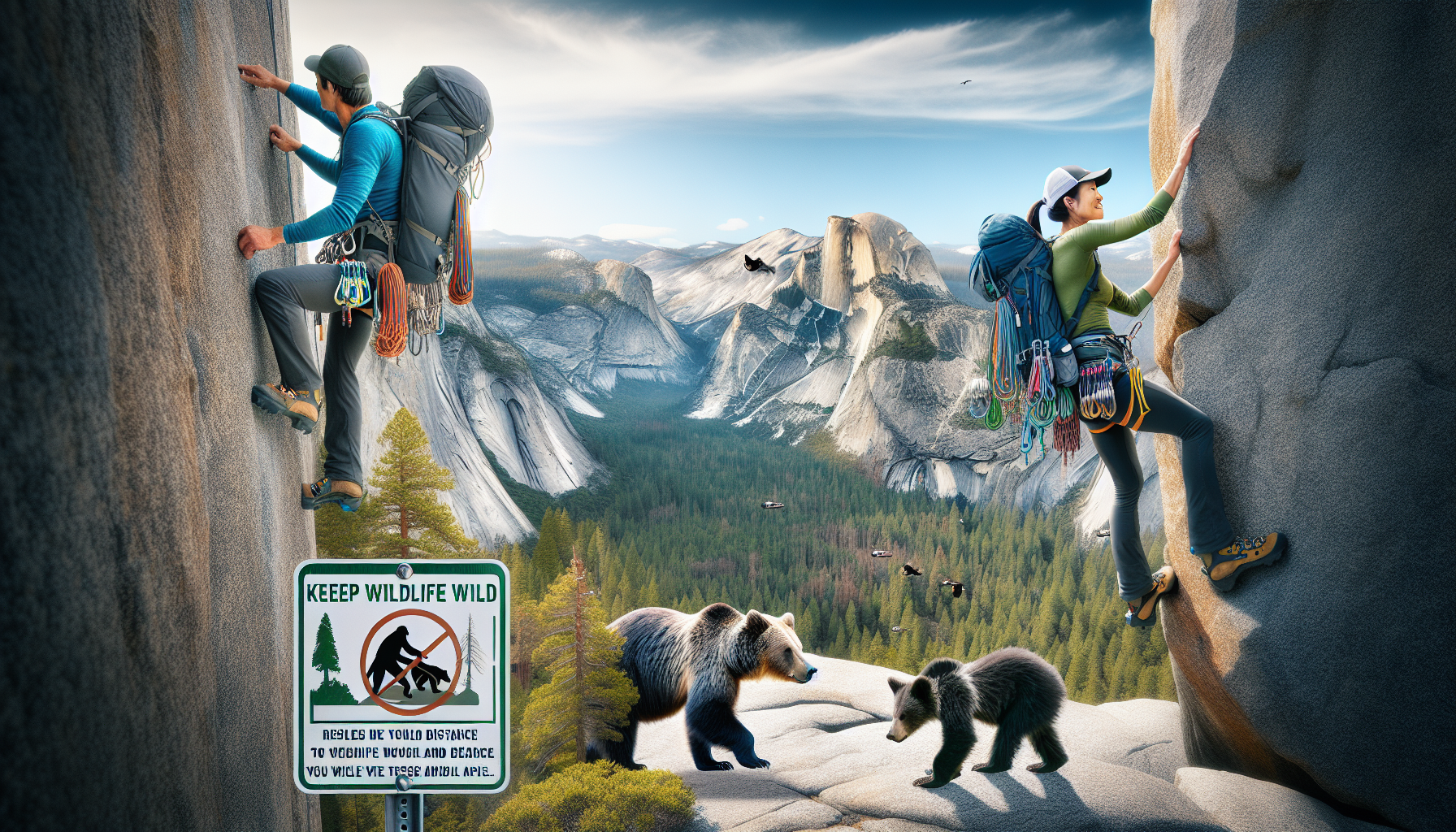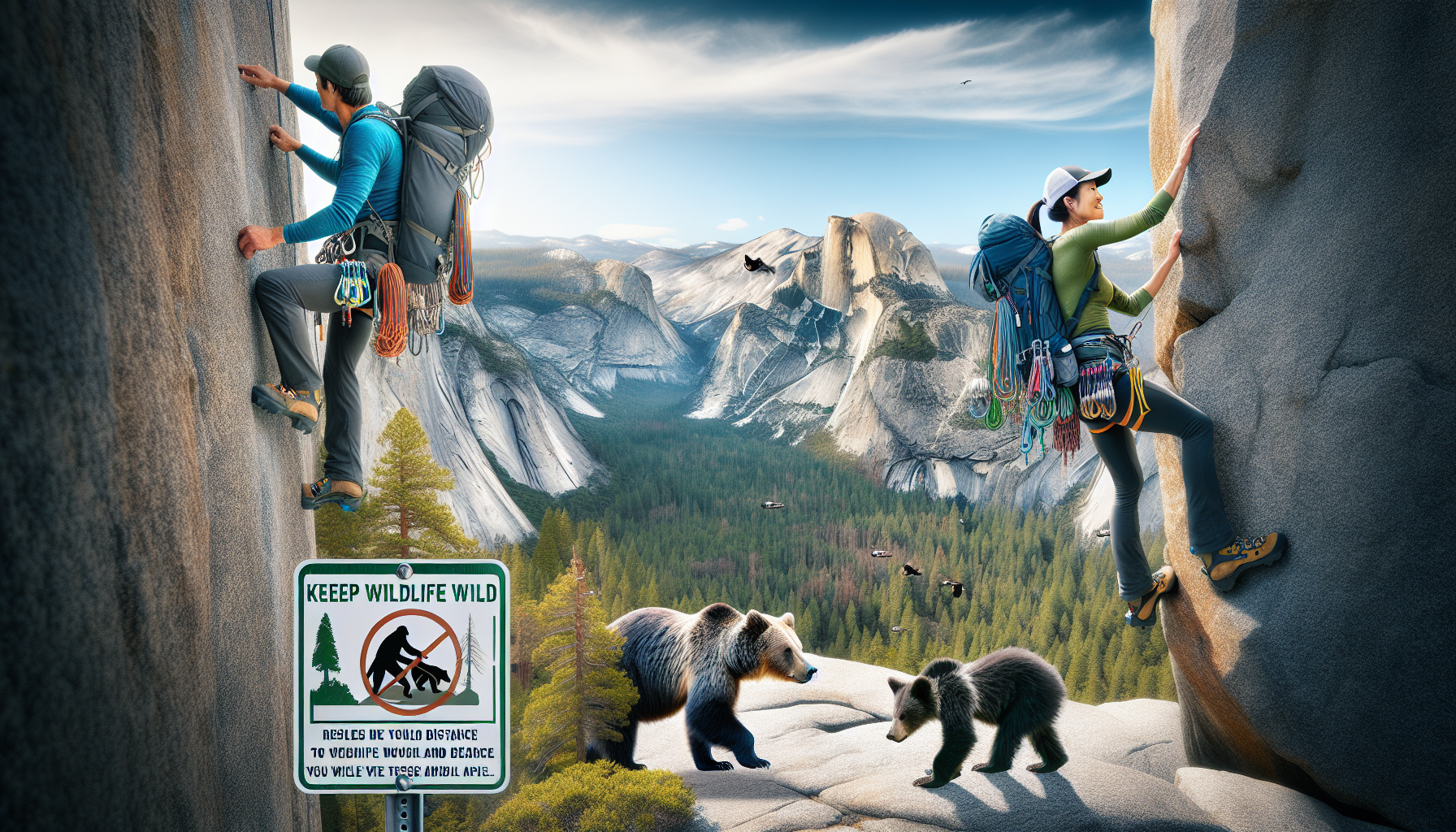
Imagine standing at the base of a majestic granite wall in Yosemite National Park, feeling the thrill of beginning a rock climbing adventure. As you gear up and prepare for your ascent, it is vital to remember that you are not the only inhabitants of this breathtaking landscape.
The article “Understanding Wildlife Guidelines for Climbers in Yosemite” sheds light on the essential wildlife considerations that climbers should know.
Embracing a friendly approach, this article serves as a valuable reminder to appreciate and respect the incredible array of animals that call Yosemite home, ensuring an unforgettable experience for humans and wildlife alike.
Introduction to Wildlife Guidelines
Climbing in Yosemite National Park is an incredible experience that allows you to connect with nature and challenge yourself physically. However, it is essential to remember that you are sharing the park with a diverse array of wildlife.
To ensure the safety and preservation of both climbers and wildlife, Yosemite has established wildlife guidelines. These guidelines provide climbers with a comprehensive understanding of how to coexist harmoniously with the park’s unique wildlife.
Understanding the Importance of Wildlife Conservation
Wildlife conservation plays a crucial role in preserving the natural balance of ecosystems and protecting biodiversity. Yosemite is home to a wide range of species, including several endangered or threatened animals.
As climbers, it is essential to understand that our presence can have unintended consequences on these fragile ecosystems. By adhering to wildlife guidelines, climbers can actively contribute to the conservation efforts of Yosemite National Park.
Respecting Wildlife Habitat
One of the fundamental principles of wildlife conservation is respecting wildlife habitat. In Yosemite, various habitats support a myriad of species.
As climbers, it is vital to educate ourselves about these habitats and understand their unique characteristics. By doing so, we can minimize our impact on fragile ecosystems and promote the well-being of wildlife.
When climbing in Yosemite, it is crucial to avoid habitat fragmentation. This means sticking to established climbing routes and avoiding venturing into areas that could disrupt wildlife corridors.
Additionally, climbers should be mindful of delicate ecosystems, such as meadows or wetlands, and take extra precautions to avoid damaging these sensitive areas.
Minimizing Disturbance to Wildlife
While enjoying the beauty of Yosemite, it is important to minimize disturbance to wildlife. Loud noises, sudden movements, or intrusive equipment can startle or stress animals, potentially disrupting their natural behavior or even causing them harm. To mitigate this, climbers should strive to be as unobtrusive as possible.
Maintaining a respectful distance from wildlife is crucial. This not only ensures the safety of both parties but also allows animals to go about their natural activities undisturbed.
Using non-intrusive equipment, such as climbing gear that does not produce excessive noise or leave a significant footprint, can further minimize disturbance to wildlife.
Climbers should also be mindful of breeding and nesting seasons. During these critical periods, animals are particularly vulnerable and easily stressed.
By altering climbing plans or avoiding areas known to be important for breeding or nesting, climbers can reduce their impact on wildlife populations.

Avoiding Direct Interactions with Wildlife
Direct interactions with wildlife should always be avoided. While encountering wildlife can be an exhilarating experience, it is crucial to prioritize the safety and well-being of both climbers and animals.
Maintaining a safe distance is paramount. While some animals may appear docile or friendly, they are still wild and should never be approached or touched.
Feeding wildlife, intentionally or unintentionally, can have detrimental effects on their behavior and overall health. It is essential to resist the temptation to share food or interact with wildlife in any way that may compromise their instincts.
If a curious or approaching animal is encountered, climbers should remain calm and avoid sudden movements. Slowly backing away from the animal while maintaining eye contact can help defuse any potential tension. Always report wildlife encounters to park authorities, as they can provide valuable information for ongoing research and conservation efforts.
Managing Food and Waste Properly
Proper management of food and waste is crucial to minimizing conflicts between climbers and wildlife. Food and waste can attract animals, potentially leading to unsafe situations for both humans and wildlife. It is essential to understand the impact of these attractants and take appropriate measures to mitigate them.
Using bear-resistant food storage containers is a mandatory requirement in Yosemite. These containers are specially designed to keep food secure and inaccessible to bears, reducing the likelihood of human-bear conflicts.
Additionally, climbers should properly dispose of trash and wastewater, following the Leave No Trace principles. By leaving climbing areas clean and free of food odors, climbers contribute to the overall health and safety of the park’s wildlife.
Honoring climbing area restrictions is equally critical. Certain areas may have specific guidelines or regulations to protect sensitive habitats or wildlife populations. By adhering to these restrictions, climbers actively participate in the preservation of Yosemite’s delicate ecosystems.
Ensuring Wildlife-friendly Campsites
Selecting suitable campsite locations and setting up camp respectfully are essential aspects of wildlife conservation during climbs.
When choosing a campsite, climbers should prioritize areas that minimize impact on wildlife and their habitat. Avoiding areas with known wildlife activity or nesting sites can help protect vulnerable species.
Setting up camp in a considerate manner is equally important. Minimizing food odors and properly securing food and smelly items are vital to avoid attracting wildlife to campsites.
Keeping a clean camp that is free from food scraps or trash reduces the chance of animals associating humans with a readily available food source. Properly storing and managing climbing gear is also crucial to prevent wildlife from damaging or scavenging equipment.
Specific Considerations for Bears
Bears are among Yosemite’s most iconic wildlife species, and extra precautions must be taken when encountering them.
Understanding bear behavior is key to reducing potential conflicts between climbers and these majestic creatures. Bears have an exceptional sense of smell and can be attracted by the scent of food or improperly stored trash.
Reducing attractants at camp is essential when it comes to bears. This includes properly storing food in bear-resistant containers and disposing of trash in designated bear-proof dumpsters.
By following these guidelines, climbers actively promote coexistence and minimize the risk of bears becoming habituated to human food sources.
In the event of a bear encounter, climbers should remain calm and avoid any sudden movements that could startle the bear. Backing away slowly and maintaining eye contact can help defuse the situation.
Carrying bear spray and knowing how to use it effectively can provide an additional layer of safety. Collaborating with park wildlife management by reporting any bear sightings or encounters allows them to track bear activity and ensure the ongoing safety of climbers and wildlife.
Specific Considerations for Peregrine Falcons
Peregrine falcons, renowned for their incredible speed and aerial acrobatics, are an integral part of Yosemite’s wildlife. During nesting season, these birds require a high level of protection to ensure successful breeding.
Certain climbing routes may be temporarily closed to protect peregrine falcon nesting sites. Climbers should respect these closures and refrain from disturbing nesting locations.
By doing so, climbers play a crucial role in facilitating the reproductive success of these magnificent birds. Park authorities provide regular updates on climbing route closures to ensure climbers can plan their trips accordingly.
Specific Considerations for Bats
Bats are vital to the ecosystem in Yosemite, as they play a crucial role in pollination and insect control. These nocturnal creatures are particularly vulnerable to disturbances during roosting or hibernation periods.
Climbers should be mindful of potential bat roosts when selecting climbing routes and avoid disturbing these areas.
If encountering bats during climbs, climbers should give them a wide berth and refrain from shining bright lights directly on them. By respecting bat habitats, climbers contribute to the preservation of these essential and often misunderstood creatures.
Conclusion
Understanding and adhering to the wildlife guidelines in Yosemite is essential for climbers who wish to enjoy the park’s natural wonders while minimizing their impact on wildlife.
By respecting wildlife habitat, minimizing disturbance, avoiding direct interactions, managing food and waste properly, and ensuring wildlife-friendly campsites, climbers actively contribute to the conservation efforts within the park.
Preserving Yosemite’s unique biodiversity and maintaining the delicate balance of ecosystems requires collaboration between climbers and park authorities.
By embracing responsible climbing practices, climbers can continue to enjoy the beauty and challenges of Yosemite while safeguarding the natural habitat that countless species call home. Through ongoing collaboration and education, we can ensure the long-term preservation of wildlife in Yosemite for future generations to experience and appreciate.
